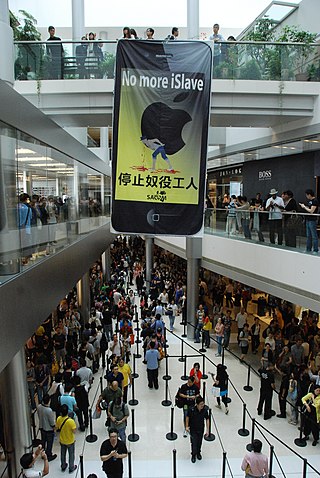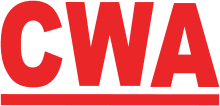The United Food and Commercial Workers International Union (UFCW) is a labor union representing approximately 1.3 million workers in the United States and Canada in industries including retail; meatpacking, food processing and manufacturing; hospitality; agriculture; cannabis; chemical trades; security; textile, and health care. UFCW is affiliated with the Canadian Labour Congress (CLC) and the AFL–CIO; it disaffiliated from the AFL–CIO in 2005 but reaffiliated in 2013. UFCW is also affiliated to UNI Global Union and the IUF.

Service Employees International Union (SEIU) is a labor union representing almost 1.9 million workers in over 100 occupations in the United States and Canada. SEIU is focused on organizing workers in three sectors: healthcare, including hospital, home care and nursing home workers; public services ; and property services.
In labor law, a union shop, also known as a post-entry closed shop, is a form of a union security clause. Under this, the employer agrees to either only hire labor union members or to require that any new employees who are not already union members become members within a certain amount of time. Use of the union shop varies widely from nation to nation, depending on the level of protection given trade unions in general.

Communications, Energy and Paperworkers Union of Canada, abbreviated CEP in English and SCEP in French, was a largely private-sector labour union with 150,000 members, active from 1992 to 2013. It was created in 1992 through the merger of three unions: the Canadian Paperworkers Union, the Communications and Electrical Workers of Canada, and the Energy and Chemical Workers Union. See below for some other unions that were merged into the CEP. CEP/SCEP was affiliated to the Canadian Labour Congress.

The Association of Flight Attendants-CWA is a union representing flight attendants in the United States. As of January 2018, AFA represents 50,000 flight attendants at 20 airlines. Since 2004, AFA has been part of the Communications Workers of America (CWA), an affiliate of AFL–CIO. AFA is also an affiliate of the International Transport Workers' Federation.

The NewsGuild-CWA is a labor union founded by newspaper journalists in 1933. In addition to improving wages and working conditions, its constitution says its purpose is to fight for honesty in journalism and the news industry's business practices. The NewsGuild-CWA now represents workers in a wide range of roles including editorial, technology, advertising, and others at newspapers, online publications, magazines, news services, and in broadcast. The current president is Jon Schleuss.
The Professional Flight Attendants Association (PFAA) was an independent union which represented the approximately 10,000 flight attendants employed by Northwest Airlines in North America. PFAA had been the bargaining agent for Northwest flight attendants from June 2003, when its members voted to end their 26-year association with the International Brotherhood of Teamsters, until the membership voted to be represented by the Association of Flight Attendants in July 2006.

Retail, Wholesale and Department Store Union (RWDSU) is a labor union in the United States. Founded in 1937, the RWDSU represents about 60,000 workers in a wide range of industries, including but not limited to retail, grocery stores, poultry processing, dairy processing, cereal processing, soda bottlers, bakeries, health care, hotels, manufacturing, public sector workers like crossing guards, sanitation, and highway workers, warehouses, building services, and distribution.

The American Federation of State, County and Municipal Employees (AFSCME) is the largest trade union of public employees in the United States. It represents 1.3 million public sector employees and retirees, including health care workers, corrections officers, sanitation workers, police officers, firefighters, and childcare providers. Founded in Madison, Wisconsin, in 1932, AFSCME is part of the AFL–CIO, one of the two main labor federations in the United States. AFSCME has had four presidents since its founding.
Joseph Anthony Beirne was an American labour union leader.
The National Association of Broadcast Employees and Technicians (NABET-CWA) is a labor union representing employees in television, radio, film, and media production. A division of the Communications Workers of America (CWA), NABET represents about 12,000 workers organized into about 35 local unions ("locals").

National Taxi Workers' Alliance (NTWA) is a United States labor union that was founded in February 1998 by organizers in New York City, as the New York Taxi Workers' Alliance. On August 3, 2011, the NTWA made history when it became the 57th affiliate of the AFL–CIO. NTWA is the first non-traditional workforce made up of independent contractors who don't work for an hourly wage to be granted membership into the AFL–CIO, the oldest labor federation in the country. The Executive Council of the AFL–CIO voted unanimously "to include the NTWA into the house of labor with a national unionize taxi drivers throughout the United States". The union is made up of 200,000 taxi workers operating 100,000 vehicles serving 1 billion riders per year.

Emma Kinema is an American labor organizer and the senior campaign lead of CODE-CWA, the Communication Workers of America's Campaign to Organize Digital Employees. In the late 2010s, while working as a quality assurance tester, Kinema volunteered as a games industry organizer and co-founder of Game Workers Unite. She was hired by the CWA union in 2020 to lead their initiative to organize video game and tech workers, the first American initiative of its kind in those sectors.
The United Office and Professional Workers of America (UOPWA) (1937–1950) was a CIO-affiliated union and one of the white-collar unions formed by the CPUSA-breakaway party of Lovestoneites.
A tech union is a trade union for tech workers typically employed in high tech or information and communications technology sectors. Due to the evolving nature of technology and work, different government agencies have conflicting definitions for who is a tech worker. Most definitions include computer scientists, people working in IT, telecommunications, media and video gaming. Broader definitions include all workers required for a tech company to operate, including on-site service staff, contractors, and platform economy workers.

Alphabet Workers Union (AWU), also informally referred to as the Google Union, is an American trade union of workers employed at Alphabet Inc., Google's parent company, with a membership of over 800, in a company with 130,000 employees, not including temps, contractors, and vendors in the United States. It was announced on January 4, 2021 with an initial membership of over 400, after over a year of secret organizing, and the union includes all types of workers at Alphabet, including full-time, temporary, vendors and contractors of all job types.

The Campaign to Organize Digital Employees or CODE-CWA is a project launched by the Communications Workers of America to unionize tech and video game workers in January 2020. It sprung out of conversations with Game Workers Unite (GWU) and employed at least two full time staff, including GWU co-founder Emma Kinema and veteran SEIU organizer Wes McEnany. In 2022, Jessica Gonzalez joined, a former Activision Blizzard QA tester.

Apple Inc. workers around the globe have been involved in organizing since the 1990s. Apple worker organizations have been made up of retail, corporate, and outsourced workers. Employees have joined trade unions and formed works councils in Australia, France, Germany, Italy, Japan, United Kingdom and the United States.













